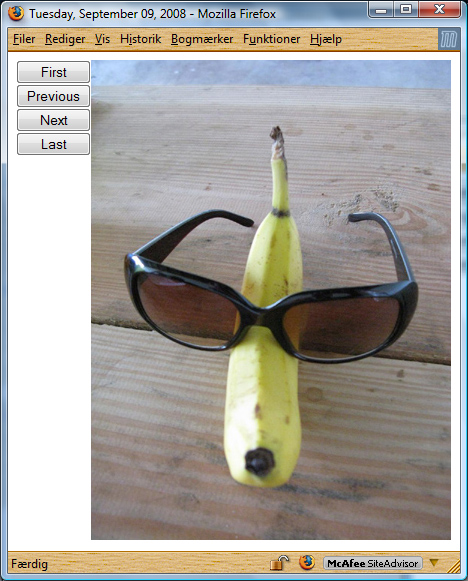
Introduction
I have written an image browser page with ASP.NET, using ASP.NET AJAX to retrieve information about the images on the server. Images are displayed using a single ASPX page and a folder with JPG files. The code-behind is written in C#. No database is involved.
Background
My goal was to show my family some photos on a web page, and hopefully spending less than a few hours accomplishing that. I wanted to do so without using a database, without titles, without descriptions, without tags, etc. However, I included the shooting date of the photo as part of the file name, since it provided a way to retain some information without using a database.
Using the code
Code-behind (C#)
I first created an ASPX web form, and in the code-behind, wrote a static web method to return information about the images on the server:
[WebMethod]
public static Image[] GetImages()
{
string imageFolderVirtualPath = "~/Photos/";
string imageFolderPath = HttpContext.Current.Server.MapPath(imageFolderVirtualPath);
List<image> images = new List<image>();
DirectoryInfo diImages = new DirectoryInfo(imageFolderPath);
foreach (FileInfo fiImage in diImages.GetFiles("*.jpg"))
{
string fileName = fiImage.Name;
string date = string.Empty;
int year = 0;
int month = 0;
int day = 0;
if (fileName.Length > 9 && Int32.TryParse(fileName.Substring(0, 4), out year)
&& Int32.TryParse(fileName.Substring(5, 2), out month)
&& Int32.TryParse(fileName.Substring(8, 2), out day))
{
date = new DateTime(year, month, day).ToLongDateString();
}
images.Add(new Image
{
Date = date,
VirtualPath = CombineVirtualPaths(imageFolderVirtualPath, fileName)
});
}
return images.ToArray();
}
A helper method combines the virtual paths:
private static string CombineVirtualPaths(string virtualPath1, string virtualPath2)
{
return string.Format("{0}/{1}", virtualPath1.Trim('~', '/'), virtualPath2.Trim('/'));
}
A helper class provides information about an image:
public class Image
{
public string VirtualPath { get; set; }
public string Date { get; set; }
}
HTML/ASPX markup
In the *.aspx file, I have the following markup:
<body onload="GetImages();">
<form id="form1" runat="server">
<asp:ScriptManager id="sm1" runat="server"
EnablePageMethods="true" EnableScriptGlobalization="true">
</asp:ScriptManager>
<div>
<div id="divButtons" style="float: left;">
</div>
<div id="divImage" style="float: left;">
</div>
</div>
</form>
</body>
JavaScript
On page load, a JavaScript method is fired that retrieves info from the page method:
var images;
var currentImageIndex = 0;
function GetImages() {
PageMethods.GetImages(GetImagesCompleted);
}
function GetImagesCompleted(result) {
images = result;
ShowImage();
}
function ShowImage() {
var currentImage = images[currentImageIndex];
var date = currentImage.Date;
var imgImage = "<img id='imgImage' alt='" + date +
"' title='" + date + "' src='" +
currentImage.VirtualPath "' />";
var dp = document.getElementById("divImage");
dp.innerHTML = imgImage;
document.title = date;
ShowButtons();
}
A separate JavaScript method displays the appropriate navigation buttons:
function ShowButtons() {
var first = "First";
var previous = "Previous";
var next = "Next";
var last = "Last";
if (Sys.CultureInfo.CurrentCulture.name.toLowerCase().startsWith("da")) {
first = "Første";
previous = "Forrige";
next = "Næste";
last = "Sidste";
}
var button1 = "<div><input type='button' style='width: 75px;'";
var btnFirst = button1 + " value='" + first +
"' onclick='ShowFirstImage();'";
var btnPrevious = button1 + " value='" + previous +
"' onclick='ShowPreviousImage();'";
var btnNext = button1 + " value='" + next +
"' onclick='ShowNextImage();'";
var btnLast = button1 + " value='" + last +
"' onclick='ShowLastImage();'";
if (currentImageIndex == 0) {
btnFirst += " disabled='disabled'";
btnPrevious += " disabled='disabled'";
}
if (currentImageIndex == images.length - 1) {
btnNext += " disabled='disabled'";
btnLast += " disabled='disabled'";
}
var button2 = " /></div>";
btnFirst += button2;
btnPrevious += button2;
btnNext += button2;
btnLast += button2;
var db1 = document.getElementById("divButtons");
db1.innerHTML = btnFirst + btnPrevious + btnNext + btnLast;
}
function ShowFirstImage() {
currentImageIndex = 0;
ShowImage();
}
function ShowPreviousImage() {
if (currentImageIndex > 0) {
currentImageIndex -= 1;
ShowImage();
}
}
function ShowNextImage() {
if (currentImageIndex < images.length - 1) {
currentImageIndex += 1;
ShowImage();
}
}
function ShowLastImage() {
currentImageIndex = images.length - 1;
ShowImage();
}
Points of interest
- A useful application built in a single web form and a folder with images.
- The
EnableScriptGlobalization feature on the ScriptManager and the ability to extract language information in JavaScript using Sys.CultureInfo.CurrentCulture.name.
This member has not yet provided a Biography. Assume it's interesting and varied, and probably something to do with programming.
 General
General  News
News  Suggestion
Suggestion  Question
Question  Bug
Bug  Answer
Answer  Joke
Joke  Praise
Praise  Rant
Rant  Admin
Admin 







